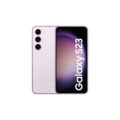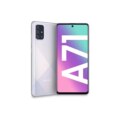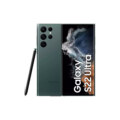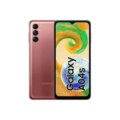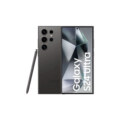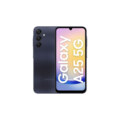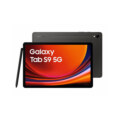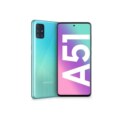Samsung Galaxy Z Fold 5



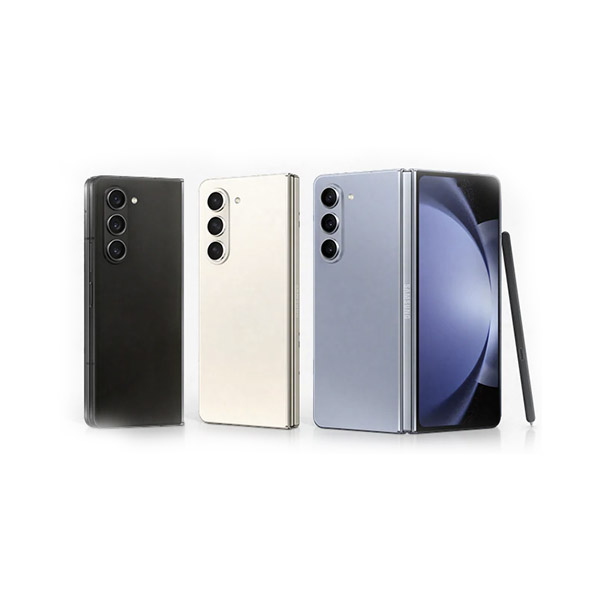
Specs
General
| Device Type | Smart Phone |
| Model | SM-F946B, SM-F946B/DS, SM-F946U, SM-F946U1, SM-F946N, SM-F946W, SM-F9460 |
| Announced | 26 July, 2023 |
| Released | 11 August, 2023 |
| Status | Available |
Design
| Water Resistant | IPX8 water resistant (up to 1.5m for 30 min) |
| Dimensions | Unfolded: (158.5 x 128.5 x 6.5 mm), Folded: (158.5 x 67.5 x 14.5-16 mm) |
| Weight | 275 g |
| Protection | Glass front (Gorilla Glass Victus 2) (folded), plastic front (unfolded), glass back (Gorilla Glass Victus 2), aluminum frame |
| Colors | Icy Blue, Phantom Black, Cream, Gray, Blue |
Display
| Refresh Rate | 120 Hz |
| Display Type Display Technology => A number of display technologies and types used in mobile phones => TFT (Thin Film Transistor), IPS (In-Place Switching), OLED (Organic Light Emitting Diode), AMOLED (Active-Matrix Organic Light-Emitting Diode), Super AMOLED (an even advanced version of AMOLED), Resistive Touchscreen (Resistive touchscreens contain two layer of conductive material with a very small gap between them which acts as a resistance), Capacitive Touchsceen (Capacitive touchscreen technology consists of a layer of glass coated with a transparent conductor) | Dynamic AMOLED 2x |
| Size | Unfolded: (158.5 x 128.5 x 6.5 mm), Folded: (158.5 x 67.5 x 14.5-16 mm) |
| Resolution | 1812x2176 px |
| Display Colors Display Colors is refers to the number of different shades of colors that the screen is capable of displaying => 64K colors, 256K colors and 16 million colors, Obviously 16M is highest available range of colors and better than others. | 16M colors, Always-on display |
| Pixel Density Pixel Density (PPI) is refers to the concentration of pixels on a particular display, measured in pixels per inch (ppi). Pixel density is calculated by dividing the diagonal pixel resolution of a display by its diagonal size, higher pixel density better display quality. | 373 ppi |
| Touch Screen | Yes, Capacitive Touchscreen, Multi-touch, Refresh Rate 120 Hz |
| Display Protection Display Protection => Gorilla Glass is a special alkali-aluminosilicate glass shield with exceptional damage resistance that helps protect mobile displays from scratches, drops, and bumps of everyday use, It is always better to go for a smartphone with Gorilla Glass for that added protection and peace of mind. | Corning Gorilla Glass Victus+ |
| Features | HDR10+ |
| Secondary Display | No |
Camera
| Front Camera | 4 MP, f/1.8, 26mm (wide), 2.0µm, under display |
| Camera Setup | Single |
| Main Camera Camera is able to capture photographs and usually videos, The most important characteristics of a camera are the resolution (measured in megapixels), lens focus type (fixed or automatic), higher megapixel cameras are known to capture higher quality photos, but not always a good measurement of the photos quality. |
50 MP, f/1.8, 23mm (wide), 1.0µm, dual pixel PDAF, OIS 10 MP, f/2.4, (telephoto), PDAF, OIS, 3x optical zoom 12 MP, f/2.2, 123˚, 12mm (ultrawide), 1.12µm |
| Image | 8150 x 6150 Pixels |
| Video | 8K@30fps, 4K@60fps, 1080p@60/240fps (gyro-EIS), 720p@960fps (gyro-EIS), HDR10+ |
| Camera Features | Geo-tagging, touch focus, HDR, panorama, |
| Flash Flash Light => There is commonly two types of flash lights are used in camera mobile phones, LED Flash (LED flash offers lower power consumption with drive circuitry that takes up very little room, LEDs can be strobed faster than any other light source), Xenon Flash (xenon flash produces an extremely intense full-spectrum white light for a very short duration) | LED flash |
Hardware
| Operating System OS => Every computer system run on a base software called Operating System (OS). Operating System controls all basic operations of the computer (such as smartphone, PDAs, tablet computers and other handheld devices). The Operating System allows the user to install and run third party applications (apps), apps are used to add new functionality to the device. | Android 13 |
| Chipset Chipset is a group of integrated circuits designed to perform one or a more dedicated functions, often with real time computing constraints, Popular smartphones are equipped with more advanced embedded chipsets that can do many different tasks depending on their programming. | Qualcomm Snapdragon 8 Gen 2 |
| CPU CPU (Central Processing Unit) mostly known as processors, CPU processes instructions in order to carry out certain functions that make your device operate properly. Processors are often described as the brain of computers, smartphones and tablets, Smartphones and tablets rely on processors to carry out their every task, Processors are an incredibly important factor in selecting any type of computing device, including your smartphone. | Octa core (3.36 GHz, Single core, Cortex X3 + 2.8 GHz, Quad core, Cortex A715 + 2 GHz, Tri core, Cortex A510) |
| Architecture | 64 bit |
| Fabrication | 4 nm |
| GPU GPU (Graphics Processing Unit) is a single-chip processor designed to rapidly manipulate and alter memory to accelerate the creation of images in a frame buffer intended for output to a display, This includes things such as lighting effects, object transformations, and 3D motion. | Adreno 740 |
| RAM (Memory) RAM (Random Access Memory) is a type of computer memory that can be accessed randomly, any byte of memory can be accessed without touching the preceding bytes that allows information to be stored and accessed quickly from random locations. RAM is the most common type of memory found in computer systems, smartphones, tablets and other electronic devices. | 12 GB |
| Internal Storage Internal Storage is a data storage space (flash memory) mostly used in smartphones, tablets and other electronic devices where operating system, apps, music, photos, videos, files and other user data Is stored. | 256 GB, 512GB, 1TB Built-in |
| Card Slot Memory Card Slot is a special slot for inserting a memory card. Memory cards allow you to expand the phone's built-in memory, A memory card (sometimes called a flash memory card or a storage card) is a small storage medium used to store data such as text, pictures, audio, and video, for use on small, portable or remote computing devices such as mobile phones, mp3 players, digital cameras. | |
| Sensors Sensors are electronic components that detects and responds to some type of input from the physical environment. The specific input could be light, heat, motion, moisture, pressure and location, The output is generally a signal that is converted to use in computing systems, a location sensor, such as a GPS receiver is able to detect current location of your electronic device. | Accelerometer, Barometer, Compass, Fingerprint (side mounted), Gyro, Proximity |
Network
| SIM TYPE SIM (Subscriber Identity Module) is a small card that contains mobile network subscriber's account information. This allows the phone using the card to attach to a mobile network. The SIM card is most commonly associated with GSM and UMTS mobile networks. Moving a SIM card from one phone to another allows a subscriber to switch mobile phones without having to contact their mobile network carrier. SIM cards can also be used by a phone to store limited amounts of data, such as phone numbers and text messages. | Nano SIM |
| SIM Technology | Nano-SIM and eSIM or Dual SIM (2 Nano-SIMs and eSIM, dual stand-by) |
| 2G Network | GSM 850 / 900 / 1800 / 1900 |
| 3G Network | HSDPA 850 / 900 / 1700(AWS) / 1900 / 2100 |
| 4G Network |
LTE |
| 5G Network | 5G Band SA/NSA/Sub6/mmWave |
Multimedia
| FM Radio | |
| Stereo Speakers | YES |
| Loudspeaker | YES |
| Audio Features |
32-bit/384kHz audio Tuned by AKG |
Connectivity
| Wi-fi Wi-Fi is a popular wireless networking technology using radio waves to provide high-speed network connections that allows devices to communicate without cords or cables, Wi-Fi is increasingly becoming the preferred mode of internet connectivity all over the world. | Wi-Fi 802.11 a/b/g/n/ac/6e/7, tri-band, Wi-Fi Direct |
| Bluetooth Bluetooth is a wireless communications technology for exchanging data between mobile phones, headsets, computers and other network devices over short distances without wires, Bluetooth technology was primarily designed to support simple wireless networking of personal consumer devices. | v5.3 with A2DP, LE, apt-X HD |
| GPS GPS The Global Positioning System is a satellite-based radio navigation system, GPS permits users to determine their position, velocity and the time 24 hours a day, in all weather, anywhere in the world, In order to locate your position, your device or GPS receiver must have a clear view of the sky. | Yes + A-GPS support & Glonass, BDS, GALILEO |
| USB | USB Type-C 3.2, OTG |
| EDGE EDGE (Enhanced Data GSM Environment) is a wireless network technology generally considered the next step in the 2G network offers data transfer rates up to four times faster than ordinary GSM networks, Generally, EDGE is used for the purpose of wireless data transfer, such as sharing pictures and videos or browsing the Internet via a mobile phone connection. | |
| GPRS GPRS (General Packet Radio Service) is a packet oriented mobile data service on the 2G and 3G cellular communication system's global system for mobile communications (GSM), Generally, GPRS is used for the purpose of wireless data transfer, such as sharing pictures and videos or browsing the Internet via a mobile phone connection. | |
| Speed | 3G (HSPA 42.2/5.76 Mbps, 4G (LTE-A (7CA) Cat20 2000/200 Mbps), 5G capable |
| Wi-fi Hotspot | |
| NFC NFC (Near field communication) is a set of standards for smartphones and similar devices to establish peer-to-peer radio communications with each other by touching them together or bringing them into proximity, usually no more than a few inches. |
Features
| Messaging | SMS(threaded view), MMS, Email, Push Mail, IM |
| Web Browser Web Browser => a web browser is a software application used to locate, retrieve and display content on the World Wide Web, including Web pages, images, video and other files, The primary function of a web browser is to render HTML, the code used to design or markup webpages. | HTML5 |
| Games | Built-in + Downloadable |
| Torch |
Battery
| Battery Type Battery Type => Cell phones run on various kinds of batteries depending on the manufacturer, phone size or shape and features. There are basically four types of cell phone batteries => Lithium Polymer, Lithium Ion, Nickel Metal Hydride and Nickel Cadmium. | Li-Ion (Lithium Ion) |
| Capacity Battery Capacity is a measure (typically in Amp-hr) of the charge stored by the battery, and is determined by the mass of active material contained in the battery. The battery capacity represents the maximum amount of energy that can be extracted from the battery under certain conditions. | 4400 mAh |
| Placement | Non-removable |
| Wireless Charging Wireless Charging (Inductive Charging) uses an electromagnetic field to transfer energy between two objects. This is usually done with a charging station. Energy is sent through an inductive coupling to an electrical device, which can then use that energy to charge batteries or run the device. | Yes |
| Extra |
25W wired, 50% in 30 min (advertised) 15W wireless 4.5W reverse wireless |
Samsung Galaxy Z Fold 5 Detailed Review
Introduction: The Samsung Galaxy Z Fold 5, launched in August 2023, continues to push the boundaries of foldable technology with significant refinements over its predecessor, the Z Fold 4. Samsung has focused on making the Z Fold 5 more durable, improving the hinge mechanism, and optimizing performance for multitasking. This review provides an in-depth look at the Z Fold 5, covering its design, display, performance, camera system, battery life, software, and more, along with a summary of its pros and cons.
Specifications at a Glance
- Display: 7.6-inch Dynamic AMOLED 2X (2176 x 1812 pixels, 120Hz), 6.2-inch cover display (2316 x 904 pixels, 120Hz)
- Processor: Qualcomm Snapdragon 8 Gen 2 (4nm) with Adreno 740 GPU
- RAM: 12 GB
- Storage Options: 256 GB, 512 GB, 1 TB (no microSD support)
- Rear Cameras: Triple system – 50 MP (wide, f/1.8), 12 MP (ultra-wide, f/2.2), 10 MP (telephoto, f/2.4) with 3x optical zoom
- Front Cameras: 4 MP (under-display) + 10 MP (cover display)
- Battery: 4,400 mAh with 25W fast charging, 15W wireless charging, and 4.5W reverse wireless charging
- Operating System: Android 13 with One UI 5.1.1
- Audio: Stereo speakers, Dolby Atmos
- Dimensions (Unfolded): 154.9 x 129.9 x 6.1 mm
- Weight: 253 grams
Design and Build Quality
Aesthetics:
- Refined Design: The Galaxy Z Fold 5 retains a similar design to the Z Fold 4 but is slightly thinner and lighter, with slimmer bezels for a more refined look.
- Hinge Improvement: The new Flex Hinge allows for a gapless fold, making the phone feel more solid when closed. The hinge mechanism is more durable and smooth, with improved flex angles.
- Color Options: Available in Icy Blue, Phantom Black, and Cream, along with exclusive colors like Gray and Blue.
Durability:
- Armor Aluminum Frame: The frame is made from Samsung’s tough Armor Aluminum for extra protection against drops and impacts.
- Gorilla Glass Victus 2: Both the front and back are protected with Gorilla Glass Victus 2, providing improved scratch and drop resistance.
- Water Resistance: The Z Fold 5 has an IPX8 rating, allowing it to survive submersion in water up to 1.5 meters for 30 minutes.
Ergonomics:
- Slim and Compact (for a Foldable): The slimmer profile makes it easier to handle than previous generations, though it’s still thicker than regular smartphones when folded.
- Fingerprint Sensor: The fingerprint sensor is embedded in the power button, providing quick and reliable access.
Summary: The Galaxy Z Fold 5’s design is sleeker, more durable, and offers better portability than before, making it the most refined foldable from Samsung yet.
Display
Specifications:
- Main Display: 7.6-inch Dynamic AMOLED 2X (2176 x 1812), 120Hz refresh rate, HDR10+ support, 1,750 nits peak brightness
- Cover Display: 6.2-inch Dynamic AMOLED 2X (2316 x 904), 120Hz refresh rate
Performance:
- Vivid and Immersive: The Z Fold 5’s foldable Dynamic AMOLED display is bright, sharp, and vibrant, delivering an excellent viewing experience for videos, gaming, and productivity.
- Smooth Refresh Rate: Both displays support a 120Hz adaptive refresh rate, providing smooth scrolling and seamless transitions during multitasking or gaming.
- HDR Content: HDR10+ enhances the viewing experience with improved contrast and dynamic range, making content more lifelike and immersive.
- Flex Mode Optimization: Flex Mode allows you to use the device at different angles for hands-free video calls, watching content, or split-screen multitasking.
Summary: The Galaxy Z Fold 5’s display is among the best in class, offering stunning visuals, excellent brightness, and smooth performance across both screens.
Performance
Hardware:
- Processor: Qualcomm Snapdragon 8 Gen 2 for Galaxy
- RAM: 12 GB
- Storage: 256 GB, 512 GB, or 1 TB (no microSD slot)
Performance Evaluation:
- Flagship-Level Speed: The Snapdragon 8 Gen 2 delivers exceptional performance, handling everything from high-end gaming to intensive multitasking with ease.
- Optimized for Multitasking: One UI 5.1.1 is optimized for foldables, allowing multiple apps to run smoothly in split-screen mode. You can open up to three apps simultaneously, taking full advantage of the large display.
- Graphics Performance: The Adreno 740 GPU ensures smooth graphics in demanding games, while the large display enhances the gaming experience.
- Cooling System: The improved cooling system helps maintain performance under heavy loads without significant thermal throttling.
Benchmark Scores:
- Geekbench 6: Around 1,800 (single-core) and 5,400 (multi-core), placing it among the top-performing smartphones of 2023.
Summary: The Z Fold 5 delivers powerful, efficient, and top-tier performance, making it perfect for productivity, gaming, and multitasking.
Camera
Rear Cameras:
- Main Camera: 50 MP wide sensor (f/1.8) with OIS
- Ultra-Wide Camera: 12 MP (f/2.2), 123° field of view
- Telephoto Camera: 10 MP (f/2.4) with 3x optical zoom and OIS
Front Cameras:
- Under-Display: 4 MP (main display)
- Cover Camera: 10 MP (cover display)
Camera Performance:
- Daylight Photography: The 50 MP sensor captures detailed, vibrant images in daylight, with excellent dynamic range and color accuracy.
- Low-Light Photography: The improved Nightography features allow for brighter and clearer images in low-light conditions, with minimal noise.
- Ultra-Wide and Telephoto: The ultra-wide camera is great for capturing expansive landscapes, while the telephoto lens provides clear zoomed-in shots.
- Video Recording: The Z Fold 5 supports 8K video recording at 24fps and 4K at 60fps, offering high-quality video capture with excellent stabilization.
Selfie Cameras:
- Cover Display: The 10 MP camera takes sharp and detailed selfies.
- Under-Display Camera: The 4 MP camera under the main display remains hidden during use, but its image quality is decent for video calls, though not as sharp as the cover camera.
Summary: The Galaxy Z Fold 5’s camera system offers flagship-level performance, though it doesn’t innovate significantly over the Z Fold 4.
Battery Life
Specifications:
- Capacity: 4,400 mAh
- Charging: 25W wired, 15W wireless, 4.5W reverse wireless charging
Performance:
- All-Day Usage: The Z Fold 5’s battery comfortably lasts a full day of moderate to heavy use, with improved efficiency from the Snapdragon 8 Gen 2 chipset.
- Fast Charging: With a 25W charger, the phone can reach 50% charge in about 30 minutes, though it’s slower compared to other flagship devices.
- Wireless Charging: Wireless charging works well, though it’s slower than wired charging.
Summary: The Galaxy Z Fold 5’s battery life is solid, with efficient power management that supports the large, power-hungry displays throughout the day.
Software
Operating System: Android 13 with One UI 5.1.1
User Experience:
- Optimized for Foldables: One UI 5.1.1 is packed with features designed specifically for the Z Fold 5, such as enhanced multitasking, Flex Mode, and the taskbar for quick app switching.
- Seamless Multitasking: The taskbar is a significant productivity boost, allowing quick access to frequently used apps and seamless split-screen multitasking.
- Customization: Samsung’s One UI is highly customizable, offering users the ability to personalize the look and feel of their device.
Future-Proofing:
- Software Updates: Samsung promises four years of major Android updates and five years of security patches, ensuring the Z Fold 5 remains up-to-date for years to come.
Summary: The software experience on the Galaxy Z Fold 5 is polished and optimized for foldable use, making it a productivity powerhouse.
Pros & Cons
Pros:
- Refined Design: Slimmer, lighter, and more durable with the new gapless hinge.
- Impressive Displays: Bright, vibrant, and smooth 120Hz displays, both inside and out.
- Flagship Performance: Snapdragon 8 Gen 2 delivers top-tier performance for gaming, productivity, and multitasking.
- Enhanced Multitasking: One UI 5.1.1 offers excellent multitasking features and Flex Mode optimization.
- Versatile Camera System: Flagship-level cameras with great performance in all conditions.
- Long Software Support: Samsung’s long-term update policy ensures longevity.
Cons:
- Expensive: One of the most expensive smartphones on the market.
- Average Battery Charging: 25W charging is slower compared to competitors.
- Bulky When Folded: Still thicker than regular smartphones when folded.
- Under-Display Camera: Image quality of the under-display camera is not up to flagship standards.
Conclusion
The Samsung Galaxy Z Fold 5 represents the pinnacle of foldable smartphone technology in 2023, offering a refined design, flagship performance, and impressive multitasking capabilities. Its versatility as both a phone and tablet, combined with top-tier camera performance and an optimized software experience, makes it ideal for power users and early adopters of foldable technology. However, the high price tag and slower charging speeds might deter some users.
Review
Disclaimer Note
All prices in Pakistan is updated daily from the price list provided by local shops and dealers but we can not guarantee that the information / price on this page is 100% correct (Human error is possible), always visit your local shop for exact cell phone cost & rate.
